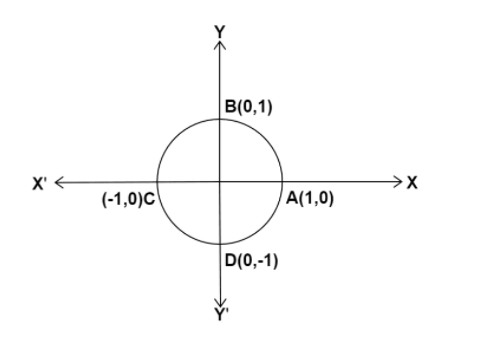
How do you find the exact value of
Answer
409.8k+ views
Hint: In order to solve this question, we will first find out the values of
Complete step-by-step answer:
We are asked to find the exact value of
So, first of all we will find out the values of
Let us consider the unit circle in which the Cartesian plane is divided into four quadrants.

Now, we know that the value
As the cosine value in the second quadrant always takes a negative value.
So, from the value of
We know that the exact value of
So,
Therefore, the value of
Now the sine value in the second quadrant always takes a positive value.
So, from the value of
We know that the exact value of
So,
Therefore, the value of
Now, we substitute the value of
Therefore, we get
Hence, the required exact value of
So, the correct answer is “-1”.
Note: We can also explain this question in another way i.e.,
We know that within the unit circle, cosine provides the x coordinate of a point on the surface of the circle and sine provides the y coordinate of a point on the surface of the circle.
At
So, the exact value of
Also, we can find the value of
And
Complete step-by-step answer:
We are asked to find the exact value of
So, first of all we will find out the values of
Let us consider the unit circle in which the Cartesian plane is divided into four quadrants.

Now, we know that the value
As the cosine value in the second quadrant always takes a negative value.
So, from the value of
We know that the exact value of
So,
Therefore, the value of
Now the sine value in the second quadrant always takes a positive value.
So, from the value of
We know that the exact value of
So,
Therefore, the value of
Now, we substitute the value of
Therefore, we get
Hence, the required exact value of
So, the correct answer is “-1”.
Note: We can also explain this question in another way i.e.,
We know that within the unit circle, cosine provides the x coordinate of a point on the surface of the circle and sine provides the y coordinate of a point on the surface of the circle.
At
So, the exact value of
Also, we can find the value of
And
Recently Updated Pages
Master Class 11 Economics: Engaging Questions & Answers for Success

Master Class 11 Business Studies: Engaging Questions & Answers for Success

Master Class 11 Accountancy: Engaging Questions & Answers for Success

Master Class 11 English: Engaging Questions & Answers for Success

Master Class 11 Computer Science: Engaging Questions & Answers for Success

Master Class 11 Maths: Engaging Questions & Answers for Success

Trending doubts
Which one is a true fish A Jellyfish B Starfish C Dogfish class 11 biology CBSE

State and prove Bernoullis theorem class 11 physics CBSE

1 ton equals to A 100 kg B 1000 kg C 10 kg D 10000 class 11 physics CBSE

In which part of the body the blood is purified oxygenation class 11 biology CBSE

One Metric ton is equal to kg A 10000 B 1000 C 100 class 11 physics CBSE

Difference Between Prokaryotic Cells and Eukaryotic Cells




